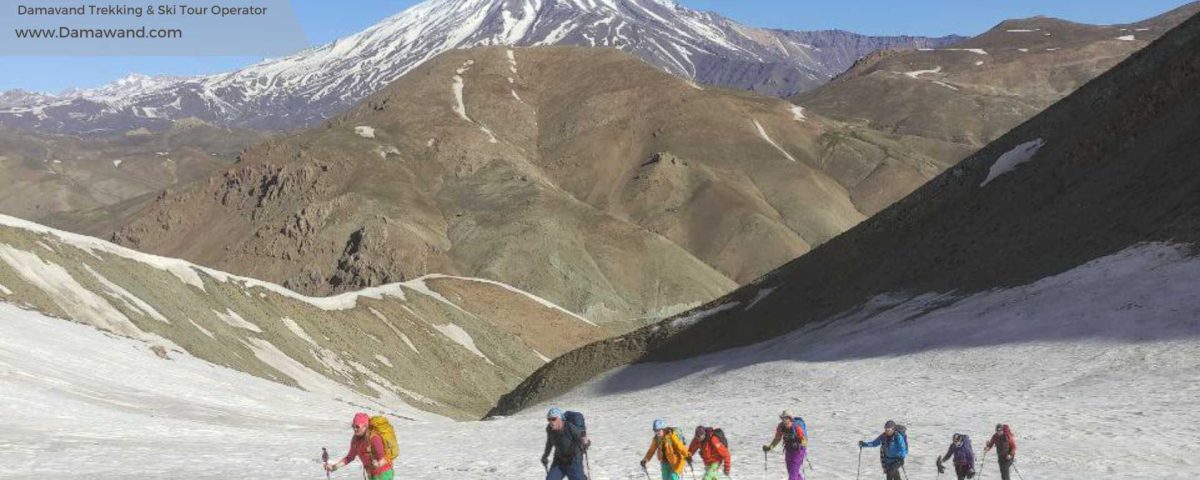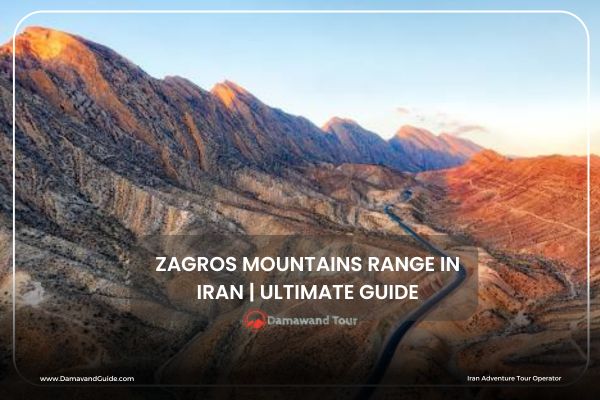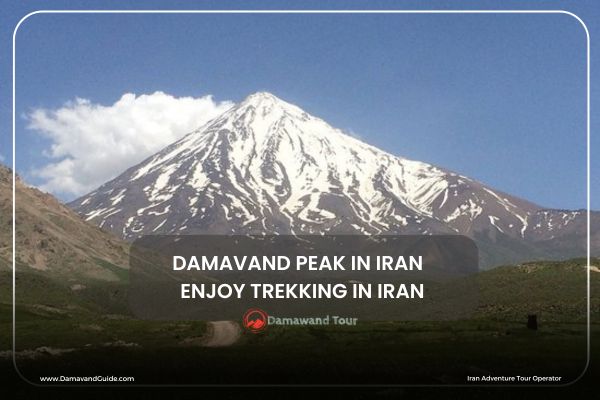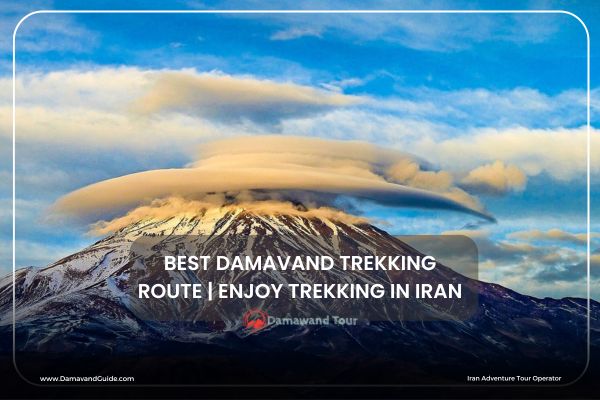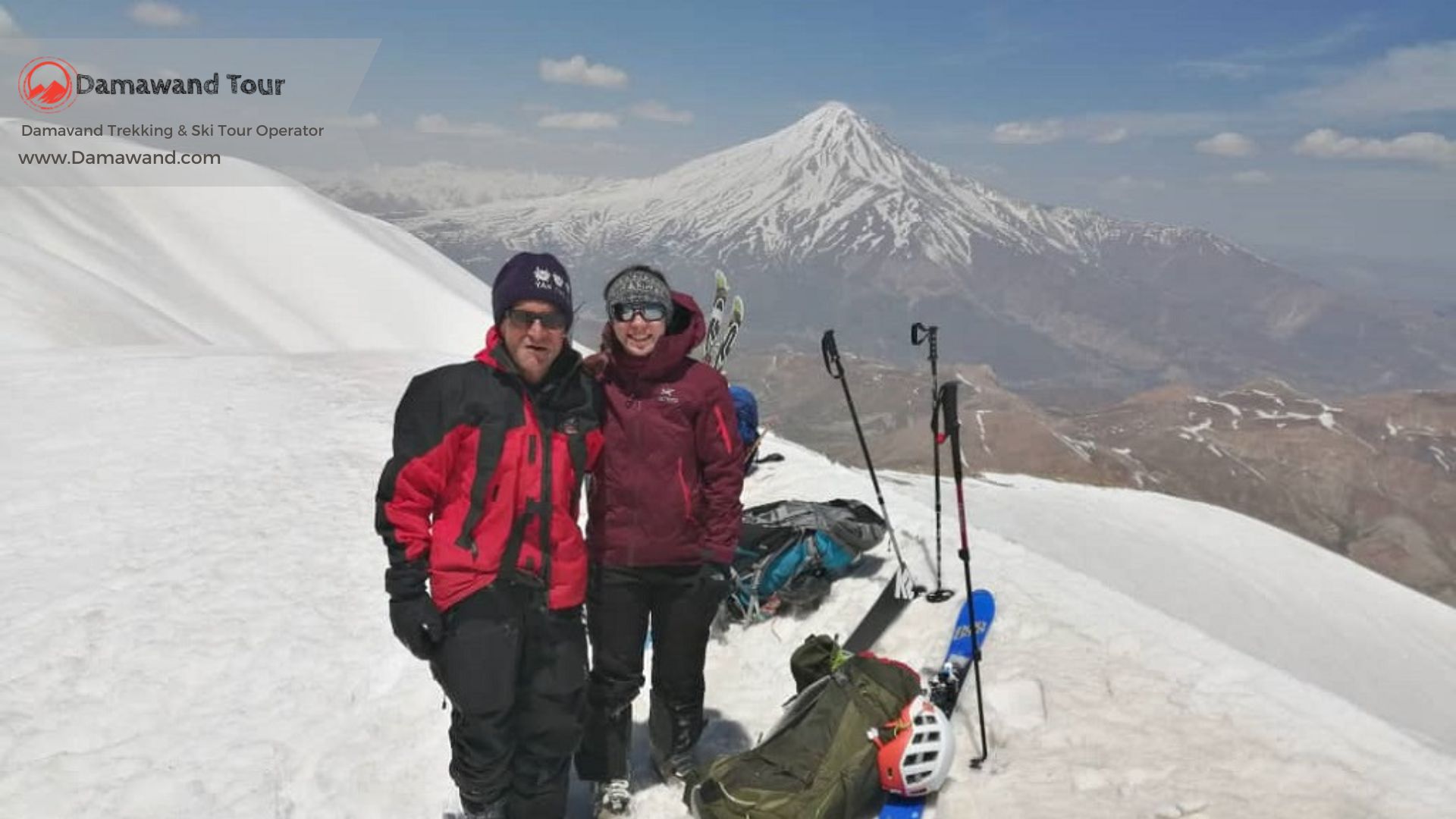
Mount Damavand Ski Tour Guide
December 9, 2022Mount Damavand Climbing Guide (Update 2025)
mount Damavand climbing guide For people who want to climb Mount Damavand and need to learn about the basics of climbing the mountain, we have included the ultimate mount Damavand climbing guide information you need to know, such as where the mountain is, the food plan, the packing of a backpack and equipment, the acclimation required for the climb, the significance of locating drinking water, the essential equipment that should be carried, the obstacles you will encounter during your climb, and the environment and weather.
Climbing to the top of Damavand is the desire of many professional climbers and hikers around the world. Not only do its technical challenges excite the professionals, but its breathtaking nature and landscapes also appeal to semi-professionals, too. Over the last few years and the growing number of tourists traveling to Iran, Trekking Iran’s nature has become a craze.
It’s important for you to know what level of physical fitness you will need; What time of the year you should climb; What days of the week you should climb; The climbing activity should commence at what time and at what pace; And much more.
If you’re an adventure junkie with a taste for the extreme, climbing Mount Damavand is definitely on your bucket list. At 5,610 meters tall, it’s the highest peak in Iran and the Middle East, making it a challenge that’s not to be taken lightly. But with the proper preparation and equipment, summiting Mount Damavand is an achievable feat. In this ultimate guide, we’ll give you all the tips and advice you need to make your climb successful.
About Iran Mt. Damavand
Mount Damavand, also known as Kooh-e-Damavand in Persian, is a super tall mountain in Iran. It’s not just any mountain; it’s an old volcano that doesn’t erupt anymore. This giant is part of the Alborz Mountain ranges, found in the north of Iran, not too far from Tehran (about 70 km northeast) and the Caspian Sea (about 70 km south).

Damavand is no ordinary volcano; it’s a majestic one, standing tall with layers of lava and ash that piled up more than 1.8 million years ago. Imagine a mountain so high that it reaches between 18,400 to 18,600 feet! That makes it the tallest peak not only in Iran but in the whole Middle East.
This incredible mountain attracts lots of people every year, especially those who love hiking and trekking. People come from Iran and other countries to climb the highest volcano in Asia. Mount Damavand isn’t just for hikers; it’s also a playground for ski lovers and air-sports enthusiasts, like paragliders.
Because of where Damavand sits and how high it is, it creates some special natural places around it, like Lar National Park. The tippy-top of Damavand is surrounded by other tall mountains between 3000 and 4000 meters high, making it a good warm-up for climbers.
These mountains, like the Doberar Sub-Mountain Range, are not just for climbers; they’re perfect for skiing adventures like Ski Touring, Backcountry Skiing, and Free Ride Skiing – some of the best in Iran! So, Mount Damavand isn’t just a mountain; it’s a whole world of excitement waiting for those who love nature and adventure.
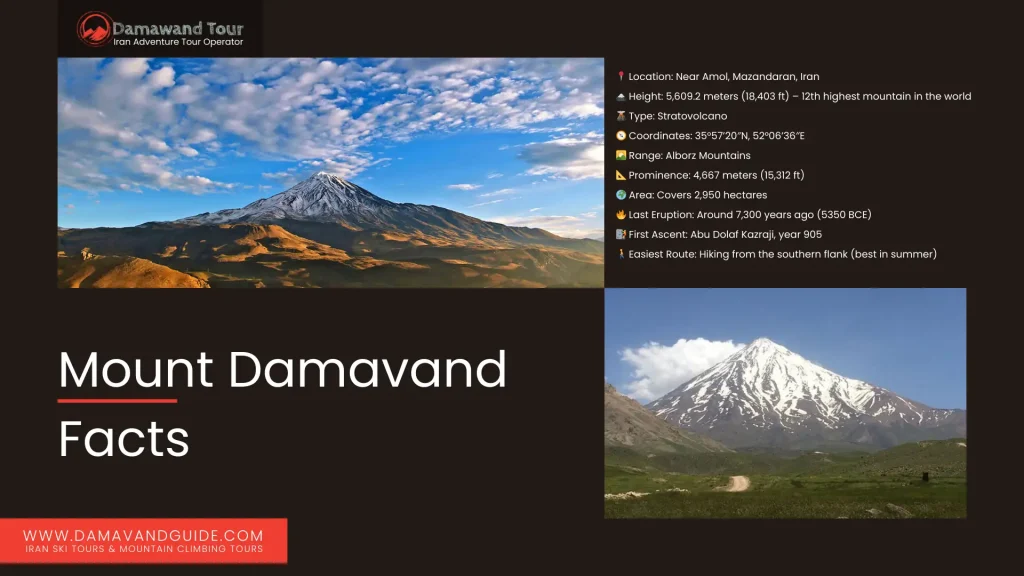
Mount Damavand Facts
Mount Damavand, also called Damavand Peak, is a majestic mountain in Amol, Mazandaran, Iran. Standing tall at 5,609.2 meters, it proudly holds the record as the 12th highest mountain globally. Damavand is not just a peak; it’s part of the Alborz-Mazandaran mountain range, showcasing its grandeur over an area of 2,950 hectares.
This stratovolcano’s coordinates are 35°57’20″N 52°06’36″E, providing a breathtaking view for those lucky enough to visit. The mountain has a rich history, with its last eruption dating back around 7300 years ago in 5350 BCE. Abu Dolaf Kazraji marked the first ascent in 905, making it a significant milestone.
For adventure seekers, the easiest way to conquer Damavand is by hiking up the Southern flank, especially during the summer months. Whether you’re a mountain enthusiast or a casual explorer, Mount Damavand promises a remarkable journey amidst its natural wonders.
Complete Name: Mount Damavand, also known as Damavand Peak.
Location in Iran: Situated near Amol, Mazandaran, Iran.
Elevation (Official Record): Stands tall at 5,609.2 meters (18,403 feet), making it the 12th highest mountain globally.
Prominence: Noteworthy prominence of 4,667 meters (15,312 feet).
Total Area Of Parent Peak: Covers an expansive 2,950 hectares.
Parent Range: Part of the Alborz mountain range in Mazandaran.
Coordinates: Positioned at 35°57’20″N, 52°06’36″E.
Mountain Type: Mount Damavand is a stratovolcano, showcasing its volcanic origin.
Last Eruption: Approximately 7,300 years ago, around 5350 BCE, according to historical records.
First Ascent: Credited to Abu Dolaf Kazraji in the year 905.
Easiest Route: The most accessible route is hiking from the southern flank, especially popular during the summer months.
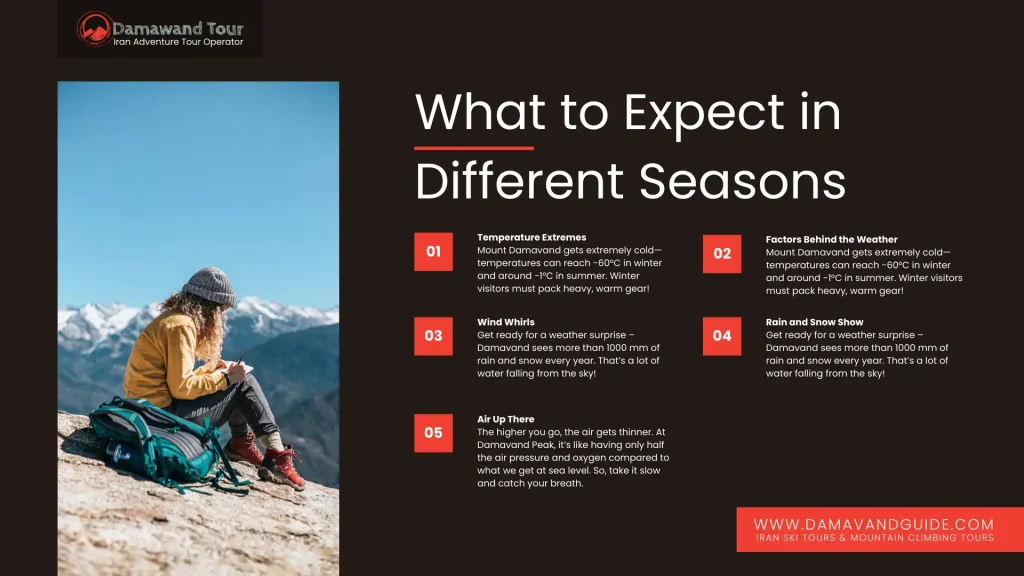
Damavand Peak in Iran: What to Expect in Different Seasons
Wondering what the weather is like on Damavand Peak in Iran? Let’s break it down in simple terms.
Temperature Extremes
Damavand experiences some seriously chilly temperatures. Picture this: in winter, it can drop to a freezing -60 degrees Celsius, while in summer, it’s milder at around -1 or -2 degrees Celsius. So, pack your warmest gear if you plan a winter visit.
Factors Behind the Weather
Several things influence Damavand’s weather. One big player is the mountain’s shape – it’s cone-like. Also, Damavand stands much taller than its Alborz Mountain buddies, over 1500 meters more! And don’t forget about the air pressure. Damavand’s peak sits way up there, while the Caspian Sea coast is way down low at -60 meters below sea level. These differences create special weather vibes at the tippy-top of Damavand.
Wind Whirls
Hold onto your hat! The wind at Damavand Peak can get wild, with speeds topping 150 km/h. Even in the lower parts, near the foothills, it can be a breezy 70 km/h during rough weather.
Rain and Snow Show
Get ready for a weather surprise – Damavand sees more than 1000 mm of rain and snow every year. That’s a lot of water falling from the sky!
Air Up There
The higher you go, the air gets thinner. At Damavand Peak, it’s like having only half the air pressure and oxygen compared to what we get at sea level. So, take it slow and catch your breath.
In a nutshell, Damavand Peak is a weather adventure waiting to happen. Whether you’re braving the cold in winter or enjoying the milder summer, be prepared for a unique climate journey up this towering Iranian mountain.
Highest Volcano of The Middle East and Tallest Mount of Iran
Mount Damavand’s elevation is 5,610 meters (18,406 ft) above sea level, making it a challenging but not extreme climb. Elevation gain is about 2609m (8559 ft). You can do it in 3 to 5 days if you’re fit; otherwise, you can take as long as you need.
Mount Damavand is a big, big mountain in Iran. It’s super tall, with a height of 5610 meters, way taller than the second-highest mountain called Alam-Kuh, which is 4850 meters. So, Damavand is the king of mountains in Iran!
People in Iran love Damavand a lot. It’s like a symbol of greatness and stability. Iranians think it’s super important. You’ll see pictures of Damavand on lots of money in Iran. Even some company logos, like Iran Insurance, have Damavand on them. If you walk around Tehran province, you might notice streets and even a city named after Damavand.
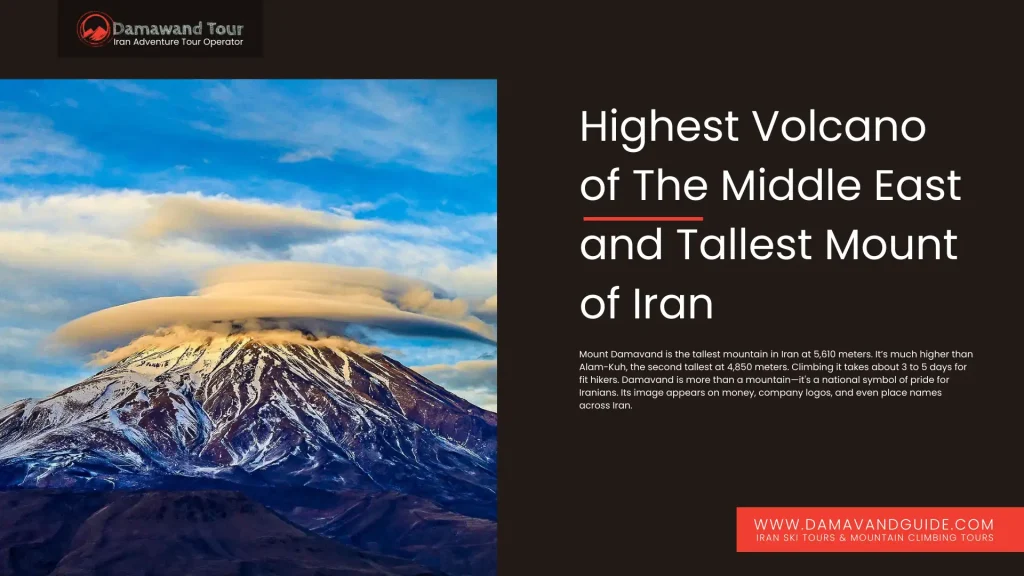
But Damavand is not just famous for being tall. It’s also a big deal in Iranian stories. In one story, a mythological character named Fereydoun took another guy named Zahak to a cave on Damavand. Zahak was stuck there forever!
Some folks who live near Damavand believe they can hear Zahak’s moans in the mountains. Isn’t that spooky? Oh, and a long time ago, when Assyrians invaded Iran, Damavand was part of a place called the Median. The Assyrians even camped at Damavand during Asrahodon’s time. But they didn’t go further because they thought the Lut desert in the south was the end of the world.
So, Damavand is not just a tall mountain. It’s a superstar in Iran, with a tall height, a place in stories, and a history with Assyrians. People really, really love Damavand there!
Mount Damavand Climbing Guide: Is It Hard to Climb?
Climbing up to the summit of Damavand is not technical. There are literally hundreds of routes that can be taken, but most climbers use one of two main routes and you can trust what mount Damavand climbing guides say. The southern route is a beautiful hike that takes you through an amazing view of the summit. It’s also shorter than the northern route.
The northern route is slightly longer but much steeper and is a harder route, even for expert climbers. So we can say it is possible, and the level of difficulty goes back to your situation and the route you take for your trek.
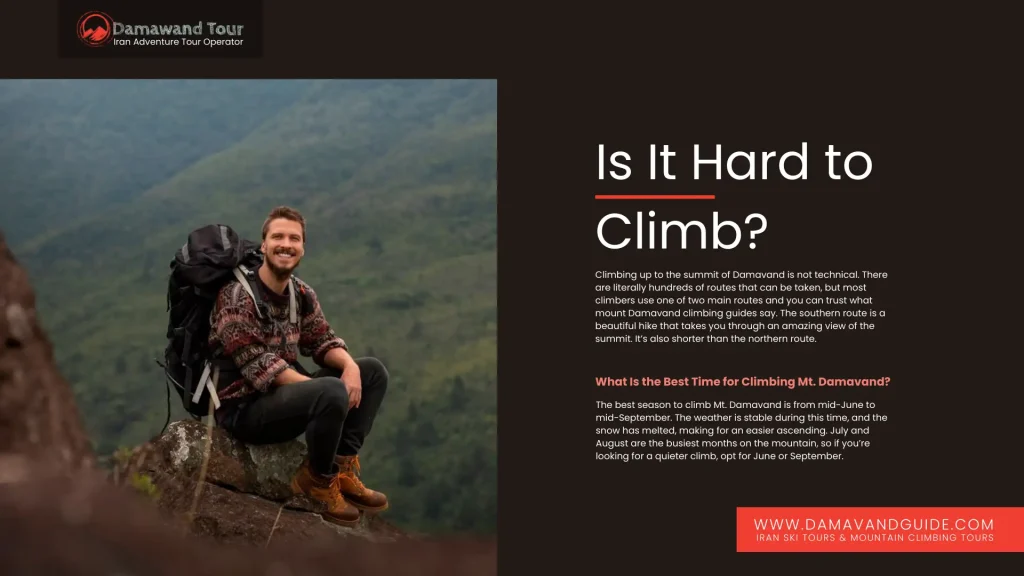
What Is the Best Time for Climbing Mt. Damavand?
The best season to climb Mt. Damavand is from mid-June to mid-September. The weather is stable during this time, and the snow has melted, making for an easier ascending. July and August are the busiest months on the mountain, so if you’re looking for a quieter climb, opt for June or September.
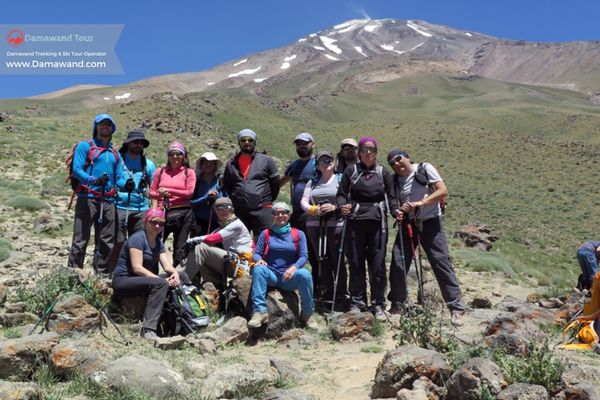
What Are the Main Climbing Routes for Mount Damavand?
For Mount Damavand climbing in Iran there are about sixteen trekking routes. Four of these routes are popular for hiking, trekking and climbing. The most popular mountainous routes to climb Mt. Damavand are the northern, northeastern, western, and southern routes.
There are shelters on each of these faces around 4000 meters in altitude. The North Face has another shelter at about 5000m. Damavand Classic South Route is the name you will hear a lot of and is the most popular side of the mountain, with a popular new mountain resort at about 4250 m. Most climbers prefer to descend from the South face due to many reasons.
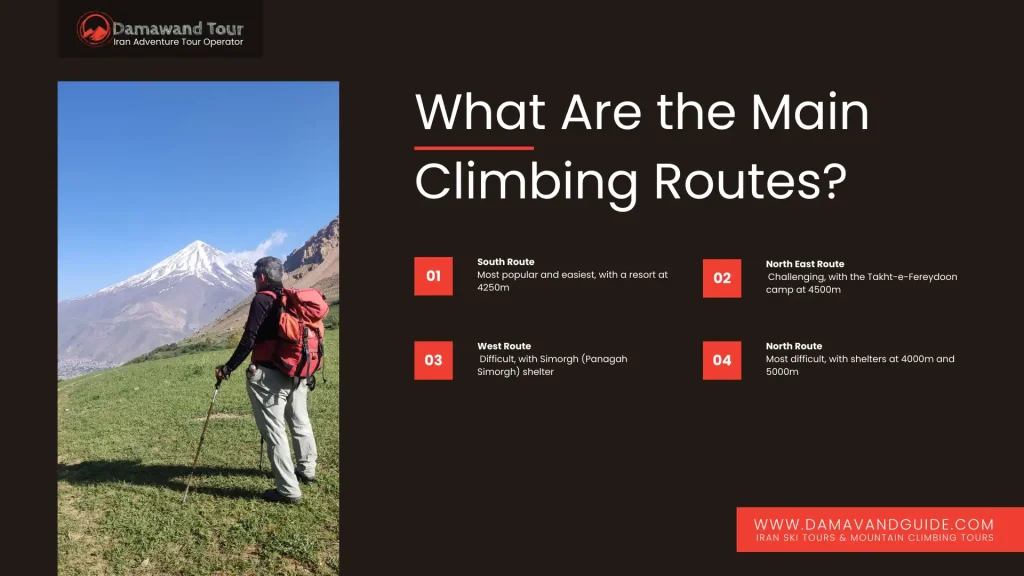
South Route
The south road of mount Damavand can be reached from Tehran or the North of Iran. Many people come from the North, and it makes this route a popular one for climbers. Also, as it takes a short time to get to Haraz’s main road from Tehran, the south route is one of the best options with a short distance.
An inefficient approach to reaching the summit is climbing from the third campsite and trekking throughout the night to reach the summit before dawn. This is a more tiring strategy and increases the chance of succumbing to mountain sickness.
Note that most people who aim to reach the peak from the West, North East or North face, like the South face, due to its proper footpath, which is very important when you are summiting a tall mountain like Mt. Damavand.

North East Route
This route is challenging to take. You will find it mountaineering and very hard to climb. Ascending and descending are along with the problem of cold and wind. Around 4500m, there is a famous camp named Takht-e-Fereydoon. This can be a good shelter if you need a rest in your challenging trek.
West Route
There is a shelter in the West route called Simorgh. You can call it “Panagah Simorgh” in the Persian language. This route is also difficult for many climbers. Snow and cold don’t let you have an easy descent on this route, and the type is basic mountaineering. So you may face challenges while walking up the mountain.
Simorgh Means Roc
In old poems of the Persian language, there are tales about Roc, which is a legendary bird with special features and is a symbol of unity and power.
North Route
Not a lot of people try this route. The North route is the most difficult one. Not only the steepness but also the cold and wind make it a very hard option. Ice and snow are the biggest problems if you reach there in winter. You will experience a hard descent, so be prepared and well-equipped. By the way, two shelters are waiting for you, called 4000 and 5000.
Mount Damavand Climbing Guide: A Guide for Hikers
Mount Damavand, the highest peak in Iran, attracts many adventurers. To conquer this challenging hike, proper planning is crucial. A guide can help you choose the most suitable route based on your experience, the South Route being the easiest and most popular. The guide will also emphasize the importance of acclimatization and the best practices for dealing with the high altitude. Remember, attempting the summit in too short a time is highly discouraged.
Are There Any Physical Requirements For Climbing Damavand?
Your first condition when scaling Mount Damavand is you need to have a suitable amount of physical endurance to go on a hike or trekking expedition.
Those who frequently partake in such activities will have an easier time climbing to the top of Damavand since it’s a relatively easy climb. A good level of physical fitness will allow you to avoid doing the final climb to the summit a struggle.
Does Mt. Damavand Have any Base Camps or Shelters?
Mt. Damavand has multiple base camps that offer mountaineers basic lodging and resting areas. Below is a list of the base camps and shelters:
- Goosfand Sara base camp on the southern track. 3000 m above sea level.
- Bargah E Sevom Sanctuary on the southern track. 4200 m above sea level.
- Simorgh Sanctuary on the western track, 4200 m above sea level.
- Chahar Hezar base camp on the northern track. 4000 m above sea level.
- Panj Hezar Shelter on the northern track. 4600 m above sea level.
- Takht e Fereydon camp on the northeastern track. 4350 m above sea level.
When Is Damavand’s Ski Season?
The ski season in Damavand lasts from early November through early May. In winter and spring, you can enjoy skiing on soft slopes. The amount of snow is different each time and each season. Because of its location that is close to the Caspian Sea, Damavand receives a great deal of snow during three seasons of the year (Fall, Winter and Spring). You can ski about 12 km down semi-hard slopes if you visit during the snow season. Maybe you want to experience an awesome Mt Damavand Ski tour.
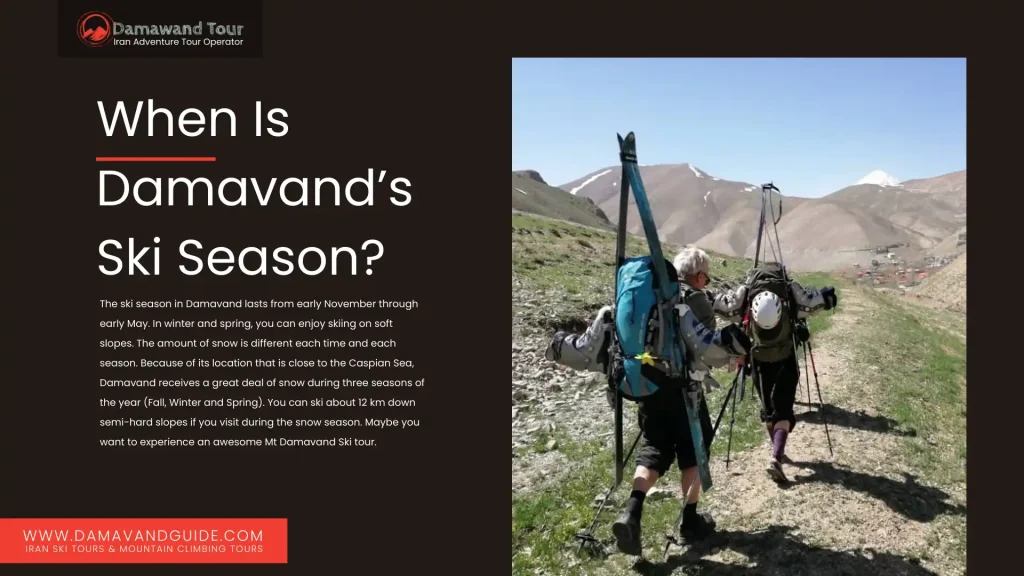
Can I Climb Mt. Damavand Solely?
Climbing Mount Damavand is an achievable feat for any experienced hiker. Although it is the tallest mountain in Iran and one of the tallest in the world, its moderate difficulty rating means that anyone in good physical condition can summit the peak. That being said, it is always best to hike with a partner, or at least in a group, as the mountain can be quite treacherous if weather conditions take a turn for the worse.
Mount Damavand Climbing Risks & Dangers
Mount Damavand Climbing can be a dangerous and risky endeavor, especially if you are not prepared. There are many risks associated with climbing Mount Damavand.
First, the mountain is located in a remote area, and there is no easy way to get help if something goes wrong. That’s why you should be well-prepared with everything you need.
Second, the weather on the mountain can be very unpredictable, and it is not uncommon for climbers to be stranded overnight due to bad weather.
Finally, because of its height, Damavand has a very thin atmosphere which can cause problems for climbers who are not used to altitude sickness. There are oxygen bags that come in handy in this situation.
Despite the risks, climbing Mount Damavand is an experience that many people cherish. Climbers should be aware of the risks and plan accordingly. In addition, climbing Mount Damavand could be done with a certified guide to help you experience a safe climb.
Food and Drinks
Food and water are very important on the mountain too. Climbers should bring enough food to last them for five days.
They should also bring a stove and plenty of fuel if they plan on cooking their own food. The mountain is very cold, so climbers should also bring warm clothing and a sleeping bag. It is notable that your equipment should be professional. If your sleeping bag does not meet the standards, it is better to replace it with a standard one.
Climbers will not find much water on the mountain, so they should bring enough to last them for their climb. They can also bring iodine tablets to purify any water they do find on the mountain.
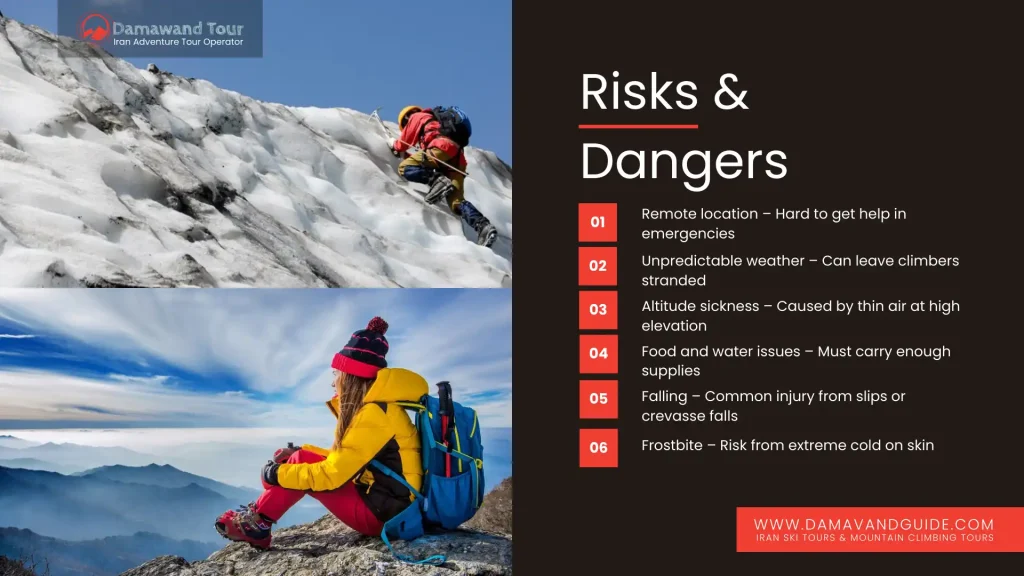
Frostbite
Frostbite occurs when the skin is exposed to cold temperatures for a long period of time. The condition is most common on the face, hands, and feet. It results in a loss of feeling and color in the affected area, and if left untreated, it can lead to serious complications or even death.
Altitude Sickness
The higher you go, the thinner the air. This makes it harder for your body to get enough oxygen. At very high elevations, like those of mountains, this can lead to altitude sickness.
Danger of Falling
The most common injuries that occur in Damavand are due to falls. Climbers fall while attempting to ascend or descend the mountain. Sometimes they fall into crevasses, which are large cracks in the ice caused by melting and/or shifting of ice and snow. Climbers also frequently fall into these crevasses while trying to cross them.
How Long Does It Take to Climb Mount Damavand?
The answer depends on a few factors, including your fitness level, experience, weather conditions, and which route you take. The average time it takes to summit Mount Damavand is 5-7 days. However, if you are an experienced climber with a good fitness level, you can do it in as little as 2-3 days.
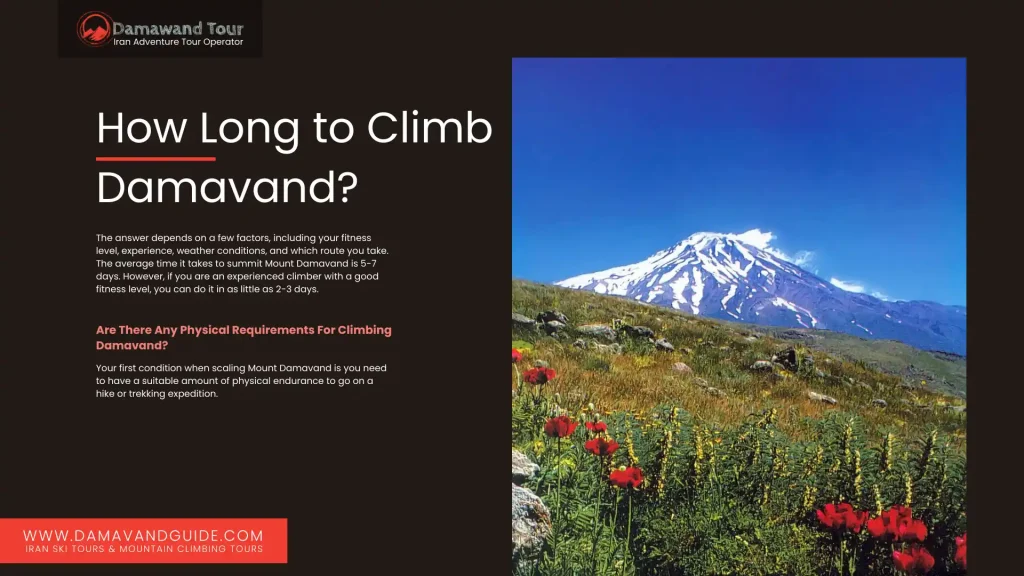
Are There Any Physical Requirements For Climbing Damavand?
Your first condition when scaling Mount Damavand is you need to have a suitable amount of physical endurance to go on a hike or trekking expedition.
What Are Essential Gear for Climbing Mount Damavand?
As a beginner, it is important to know what gear is essential for the mount Damavand trekking tour in Iran. This list will help you get started with the basics.
Climbing Shoes
Climbing shoes are one of the most important pieces of gear for climbers. They provide grip and support while you are climbing. There are many different types of climbing shoes, so it is important to choose the right ones for your feet and your style of climbing.
Harness
A harness is another essential piece of gear for climbers. It keeps you safe while climbing by attaching you to the rope. There are many different types of harnesses, so it is important to ask other people about the best brands and styles in the market. Don’t forget to buy the best ones for professional use only.
Belay
A belay device is also a vital tool to carry when climbing. It is used to control the rope while you are belaying or holding the rope for another climber.
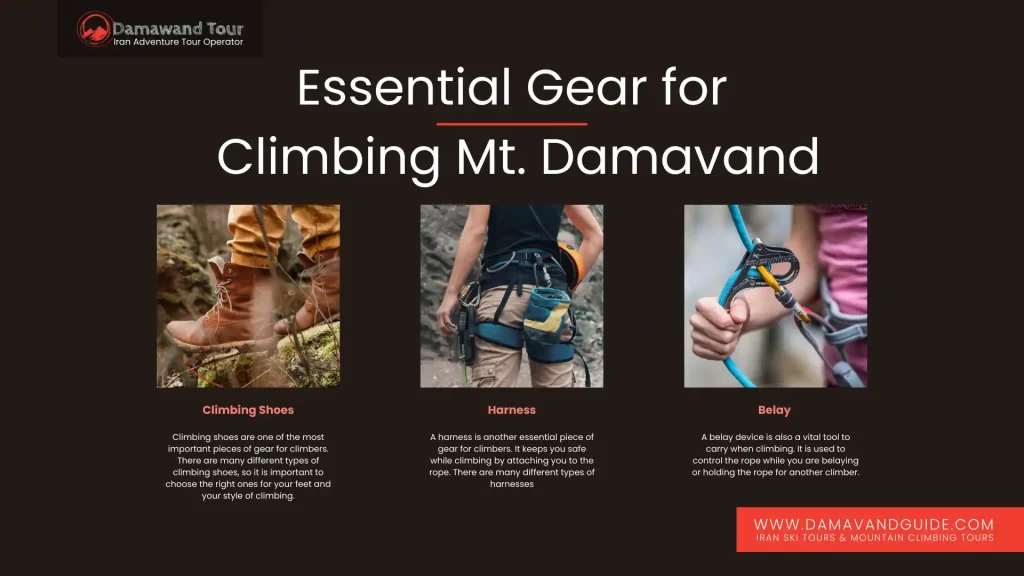
A takeaway Note for Mount Damavand Climbing Guide
It is very important to use other people’s experiences. We strongly recommend you get a professional mount Damavand climbing guide to enhance the level of your experience and enjoy your climbing. It is also safer as he or she can lead you through the best routes and help you survive in the best way possible. Never forget that there are many things you must learn about this mountain; ask experienced ones.
Damavand Climbing tours are among the top-rated adventures for those seeking to conquer Iran’s highest peak. The mountain stands tall at 5,610 meters, offering a challenge for climbers and skiers alike. For those interested in winter sports, the Best Mount Damavand Ski Tours provide a thrilling opportunity to experience its snow-covered slopes. These tours ensure participants have access to the best skis and necessary equipment, making the journey both safe and enjoyable.
Mount Damavand is popular for both summer and winter excursions, attracting adventurers from around the world. Guides are available to assist climbers in navigating the terrain and dealing with altitude challenges. The breathtaking views and unique landscape make Damavand a must-visit destination for outdoor enthusiasts. Whether you’re a seasoned climber or a novice skier, Mount Damavand Climbing tours offer an unforgettable experience filled with adventure and natural beauty.

